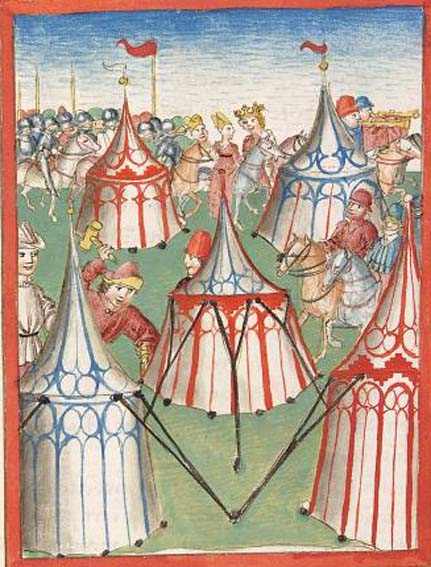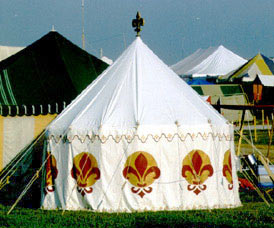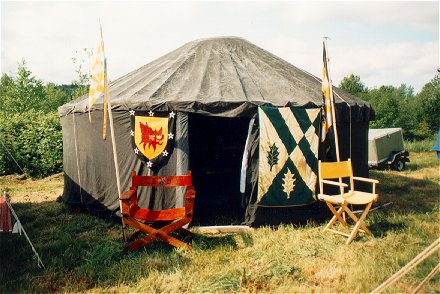Tent
| This article may require cleanup. The specific problem is: entire article in last form instead of paragraphs. Relevant discussion may be found on the talk page. Please help improve this article if you can. (April 2016) |
A tent is a shelter consisting of sheets of fabric, hides or other material draped over or attached to a frame of poles or attached to a supporting rope. While smaller tents may be free-standing or attached to the ground, large tents are usually anchored using guy ropes tied to stakes or pegs. First used as portable homes by nomadic peoples, tents are now more often used for recreational camping and temporary shelters.
Types
All the tents listed here had a canvas fabric and used a substantial number of guy ropes (8 to 18). The guys had to be positioned and tensioned fairly precisely in order to pitch the tent correctly, so some training and experience were needed. This made these styles relatively unsuitable for casual or occasional campers. Pup tents might use wooden or metal poles, but all the other styles mentioned here used wooden poles.
- A pup tent is a small version of a ridge tent intended for 2 or 3 people. It usually has a rectangular floor of size ranging from 4 ft by 6 ft up to 6 ft by 8 ft, and ridge heights ranging from 3 ft up to 5 ft. The side walls are usually about 1 ft high. There are guy ropes for each pole, at each corner, and in the centre of each side, and these guy ropes help to maintain the required shape. Earlier versions had a single upright pole at each end, while later versions often have two poles at each end, arranged rather like an 'A' shape, in order to make access easier. Some models have a horizontal ridge pole joining the tops of the end poles to support the centre of the tent.
- A ridge tent can sleep 5 to 8 people. They usually have a rectangular floor of size ranging from 8 ft by 10 ft up to 10 ft by 16 ft, and ridge heights around 6 ft to 7 ft. The side walls are usually about 3 ft high. They normally have a single upright pole at each end with the tops joined by a horizontal ridge pole. Longer models might have an additional upright pole in the centre to help support the ridge pole. They often have two guy ropes at each corner, and guy ropes every 2 ft along the sides. If strong winds are expected then two additional storm guy ropes are attached to the top of each pole.
- A square centre-pole tent was often used for family camping in the first half of the 20th century. Despite the use of 9 poles and 12 guy ropes, such a tent could be pitched by an (experienced) family of four in some 10 to 15 minutes. These tents had a square floor of size ranging from 8 by 8 ft up to 15 by 15 ft. There were poles about 5 ft high at each corner and in the middle of each side, and a 10 ft or 12 ft pole in the centre - the walls were vertical and the roof was pyramid-shaped, so there was plenty of headroom over most of the tent.
- The Sibley design differed from other conical tents, or bell tents (see photograph below), of the times in a number of ways. Sibley's design was supported by a central pole which would telescope down into the supporting tripod so that it took less space to pack and store. The tripod could be erected over a firepit for cooking and heat. The Sibley design also requred no guy ropes, being held down by twenty four pegs around the base. Additionally, unlike earlier designs, the use of a cowl over the central pole allowed for ventilation and for the escape of smoke, regardless of wind direction.
- A Butterfly Tent These were used by nomadic traders in North Africa from around the 16th century and contained one of the first recorded methods of air conditioning. More information can be found on the Butterfly Tents page.
- A chum (pronounced "choom") is a temporary dwelling used by the nomadic Yamal-Nenets and Khanty reindeer herders of northwestern Siberia of Russia. It has a design similar to a Native American tipi but it is less vertical, and it is very closely related to the Sami Lavvu in construction, but is somewhat larger in size. Some chums can be up to thirty feet (ten meters) in diameter. [1] The traditional chum consists of reindeer hides sewn together and wrapped around wooden poles that are organized in a circle. In the middle there is a fireplace used for heating and to keep the mosquitoes away. The smoke escapes through a hole on top of the chum. The canvas and wooden poles were usually quite heavy, but could be transported by using their reindeer. The chum is still in use today as a year round shelter for the Yamal-Nenets and Khanty people of Russia.
In Russian use, the terms chum, yurt and yaranga may be used indiscriminately.
- A fly refers to the outer layer of a tent or to a piece of material which is strung up using rope as a minimalist, stand-alone shelter. In basic terms, a fly is a tent without walls. Since the advent of water-proof materials a fly is unnecessary as an outer layer to the tent. Purpose-made stand-alone flies are also sometimes referred to as bivouacs, bivvies, tarpaulins, or hootchies. Flies are generally used for keeping moisture (such as condensation or rain) or sun off people while they eat, rest or sleep. They can also be used as groundsheets, but this is not recommended since it creates wear and tear which can lead to holes.
- A loue (or loude) is an ultra-light Finnish open tent used to give shelter from wind and rain during rest stops or over-night camping during hikes. Loues are popular as one or two person shelters because they are compact, light (2.2 lbs or 1 kg) and can be set up and taken down quickly.
A loue consists of a roughly conical section of fabric with the bottom edge grounded by stakes and the tip raised with a single pole. Young trees may be used temporarily to suspend the fabric without doing permanent damage. It's possible to use a camp fire for warmth and cooking, provided that the loue is upwind. In the summertime, a mosquito net may be used for comfort.
- A tipi (also teepee, tepee) is a conical tent originally made of animal skins or birch bark and popularized by the Native Americans of the Great Plains. Tipis consist of four elements: a set of ten to twenty sapling poles, a canvas or hide cover, an optional inner canvas or skin lining, and a canvas or skin door. There may also be an optional partial ceiling. Ropes and pegs are required to bind the poles, close the cover, attach the lining and door, and anchor the resulting structure to the ground. Tipis are distinguished from other tents by two crucial innovations: the opening at the top and the smoke flaps, which allow the dweller to cook and heat themselves with an open fire, and the lining that is primarily used in the winter, which insulates while providing a source of fresh air to fire and dwellers.
- In its tent version the goahti is also called a 'curved pole' lavvu, or a 'bread box' lavvu as the shape is more elongated while the lavvu is in a circular shape. It is also sometimes covered with sod and made permanent. Traditionally, the Sami transported the whole disassembled structure by having their domesticated reindeer being used as a pack animal to carry or drag the poles while following their reindeer herd. Today, because of the awkward size of the curved poles, this structure is used less often by the Sami as a transportable shelter.
- A wigwam or wickiup is a domed single-room dwelling used by certain Native American tribes. The domed, round shelter is used by many different Native American cultures. The curved surfaces make it an ideal shelter for all kinds of conditions. These structures are formed with a frame of arched poles, most often wooden, which are covered with some sort of roofing material. Details of construction vary with the culture and local availability of materials. Some of the roofing materials used include grass, brush, bark, rushes, mats, reeds, hides or cloth.
- A yurt is a portable, felt-covered, wood lattice-framed dwelling structure used by nomads in the steppes of Central Asia. Traditional yurts consist of a circular wooden frame carrying a felt cover. The felt is made from the wool of the flocks of sheep that accompany the pastoralists. The timber to make the external structure is not to be found on the treeless steppes, and must be traded for in the valleys below.
Links
- Make a period Pavilion
- How to Make a period Pavilion
- How to make a period Pavilion
- Pavilion Resources
- How to make knock down camp furniture
- Instructions on making a 'Louteen'
- History and photos of Tipis
- How to make Yurts, Practical information
- Build your own Yurt
- How to make a Wikiup
- Taxidermy of tent Designs
- Purchase medieval Pavilions
- How to make your own Pavilion
- How to make a Single pole pavilion
- Purchase Medieval Pavilions



